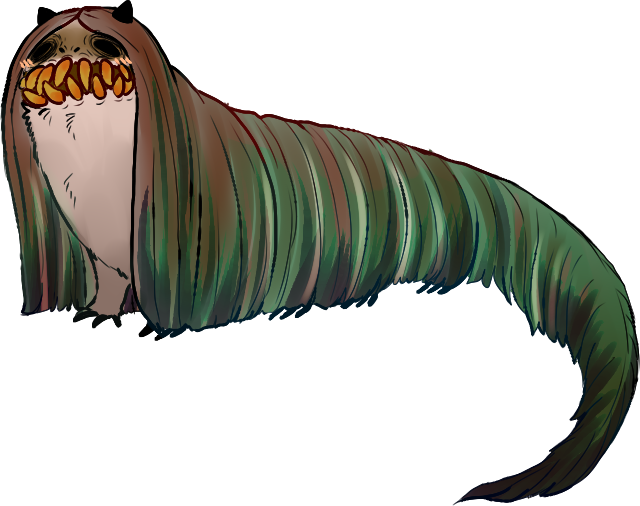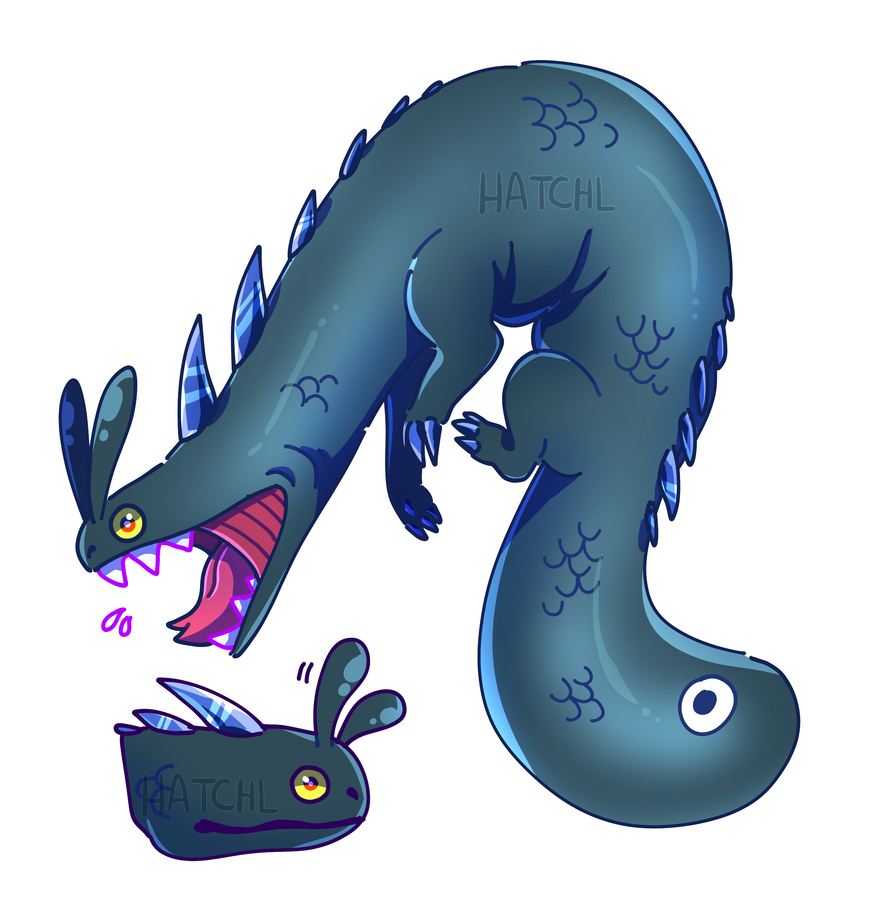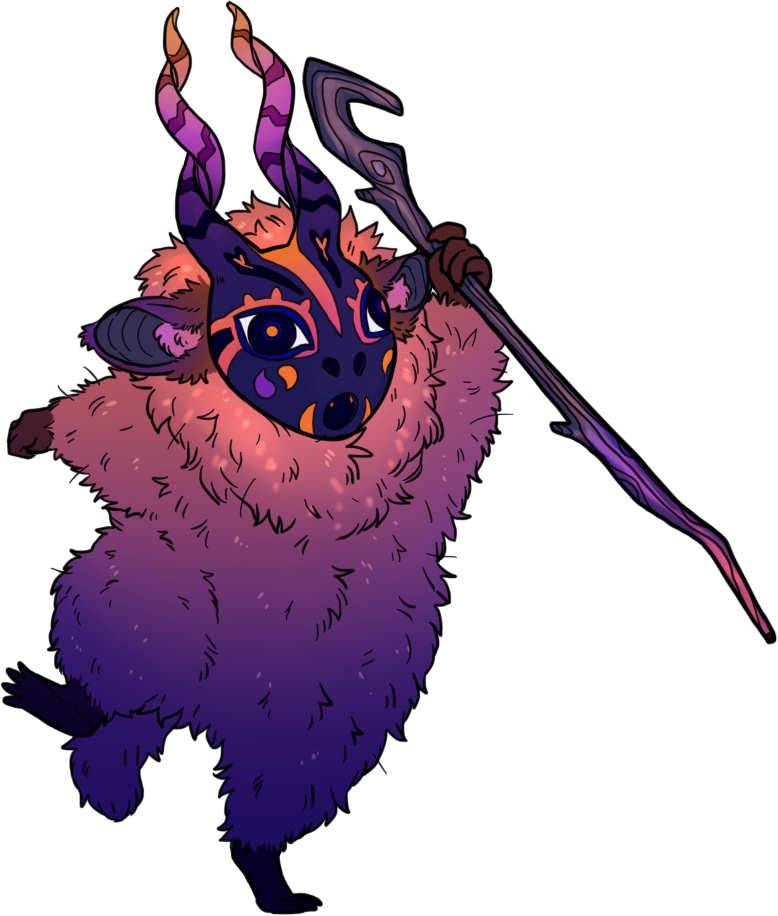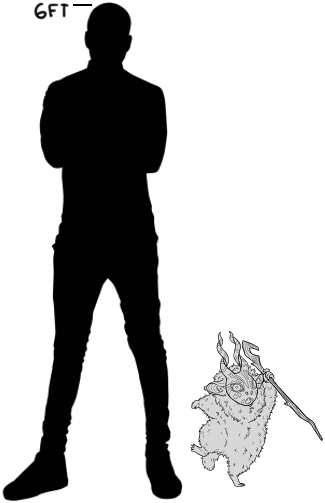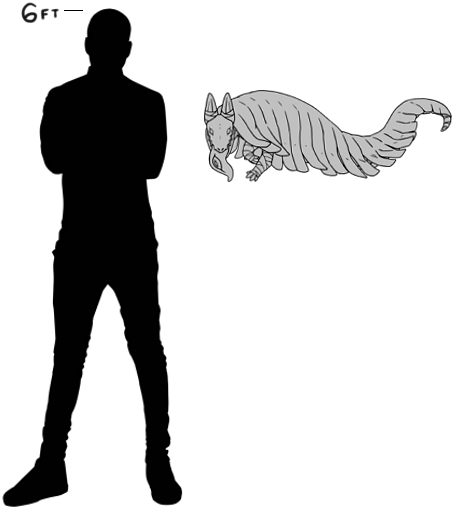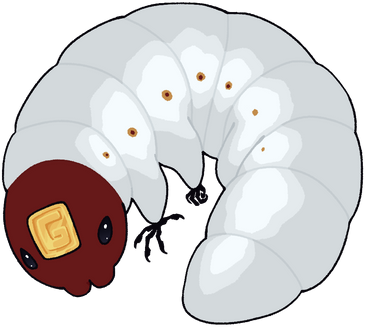Species
Snuffle
Status: Companion
Species Availability: Open , can make your own
Introduced / Native: Native
Size: 1ft
Location: Zamos Region & Nacht Isle
Habitat: Coastal Regions & Islands
Base: (Base Link) You are only able to use this base if you own a ticket to create one!
-------------------------
Description:
Snuffles are multi-legged creatures with long fur that covers their entire body, and a set of gnarled teeth, and small beady eyes.
These creatures cruise across shallow waters and tidepools for free meals, using their outward pointing teeth to cleanly open shellfish and crush crustaceans. Their fur is thick and bristly in nature, making it a perfect environment for moss and other creatures to grow within it, creating its own unique ecosystem. This makes their fur come out green and fuzzy, which Snuffle’s will use for camouflage.
Some cultures considered snuffles to be the reincarnated souls of cursed humans due to their appearance. Looking into a snuffle’s eyes was considered a bad omen to these people, and so they were typically culled to ward off bad spirits. This practice, along with habitat loss and poaching, has caused this species to become critically endangered in its main habitats.
They do however thrive in the pet trade, as they are easy to domesticate and raise, making them perfect companions for people with a particular niche.
Misc Facts:
- Some Snuffles can harbour many species in their fur alone, including a species of crab (Snuffle Crab) that only live in their fur.
- Snuffle mothers use the used dens of other species to have their young, they can have up to 6 in a litter.
-------------------------
Basic Design Rules
Physical Requirements:
-
Must have at least 4 sets of feet
-
Fur covering the whole body
-
(optional) Can be draw covered in moss and algae
-
Eyes must be small and black
-
Teeth must be gnarled and outward
- (optional) 1 set of small horns
Available Colours & Markings ✔️
- All colours & natural patterns are available (Eg: spots, stripes, gradients, rings, etc)
Spectapede
Status: Companion
Species Availability: Open, Can make your own
Introduced / Native: Native
Size: 7-30 Cm
Location: Everywhere except cold continents
Habitat: Shaded & dark environments, Graveyards, Shrines/Places of worship
Base: (Spectapede) You are only able to use this base if you own a ticket to create one!
-------------------------
Description:
As the sun sets, this mysterious insect begins to be at its most active. Levitating around in search of new habitat to occupy and new pastures of rotting wood, fungi and moss to graze upon. Spectapedes are a welcomed creature in many areas for their ecological importance of being a natural clean up crew for feeding on detritus and any other naturally decaying material.
These invertebrates have a very special ability of absorbing and storing energy in their bodies, which they use to float around effortlessly through the air. This ability, as well as their ghoulish markings had earned them their ghostly name, as many depict them as being little wandering souls as they float around..
Many cultures deem spectapedes as the “carriers of lost souls”, believing them to be the ones to transport the dead to the other side. It can be common for people to use them for burial practices to help “pass on the soul” as a means to put them to final rest.
Misc Facts:
- This species uses soul energy and bundles them up into a ball, using this energy as their main form of locomotion.
-------------------------
Basic Design Rules
Physical Requirements:
- Required to have a great number of legs. (Similar to a centipede)
- Must have markings on Carapace in the form of a scary face.
- Tail end must be in a "wisp" formation.
- 2 sets of eyes are required. (see visual for reference)
Available Colours & Markings ✔️
- Can be any colour but carapace must be dark in colour.
- Natural Markings are available (stripes, spots, gradients, rosettes, points, etc.)
Colour Range
(display what colour ranges they can be here)
-------------------------
Extra visuals can be provided here, but it's suggested to keep those visuals to the main image.
Storg
Species created by Backwardssnappy
Status: Companion
Species Availability: Closed, Cannot make your own
Introduced / Native: Native
Size: 1-2 ft
Location: Ref
Habitat: Wet rocky outcrops and overhangs, garbage dumps
Base: (Base Link) You are only able to use this base if you own a ticket to create one!
-------------------------
Description:
Storgs are a stone-like frog shaped species found typically along rocky caves and outcrops. They gather in dark habitats, specifically moist caves and crevices to avoid drying out their skin completely from direct sunlight. Sun sensitivity and limited food options can typically keep a population of Storgs in check. However this species is considered highly invasive if introduced in just the right climate and habitat.
Their stony tough skin makes them difficult to deal with, and are highly toxic as their organs are filled with acidic chemicals that can cause them to erupt under blunt trauma or high stress. They also have other defense mechanisms including projectile vomiting foreign objects to their attackers.
This acidic saliva can be highly useful for storgs, aiding in immediate digestion. Storgs are often considered the “Garbage Disposal Frog” for their ability to eat just about anything without any adverse effects. With such an appetite, invasive species of storg can normally be found raiding dumps and cities for trash consumption.
Despite their positive ability to clean up man’s trash, they are aggressive breeders if the environment has enough food involved, this has caused storgs to be a very large problem in some places, where they are deemed as pests and are required to be rounded up & controlled during particular breeding seasons.
-------------------------
Basic Design Rules
Physical Requirements:
- False eyes , the inner ring needs to glow.
- Fake mouth below false eyes.
- Real secondary mouth. (glows the same colour as the eyes)
- Fat little body with four stout legs abd featureless feet.
Available Colours & Markings ✔️
- Colours should range only within the “stone” or “Moss” range of colours. From blacks, to greys, dark browns, and greens.
-
Markings are limited to natural stone texture (Spots, Stripes, Marbling, Moss, Splotches, Gradients)
-------------------------
Switcher eel
Status: Companion
Species Availability: Closed, Cannot make your own.
Introduced / Native: Native
Size: 19 In (50.8cm)
Location: Mezza & Austrum Continents
Habitat: Dark Cave & Tidepool Environments
Base: (Base Link) You are only able to use this base if you own a ticket to create one!
-------------------------
Description:
Switcher eels are a versatile creature with long scaley bodies that can live both on land and in water. They are able to adapt their bodies to either environment if left stranded for an ample amount of time, changing their scales and make up to fit the needs of said area to survive. You can find them primarily in tidepools, rocky outcrops, caves, and intertidal flats. The diet of this omnivorous animal is made up of sea grass, bugs, crustaceans, and small animals if given the chance.
They are also known for their consumption of specific crystalline structures, used specifically during breeding season as this compound provides an extra layer of protection to their eggs. In the past, this same crystal had be overmined in many of it's home regions, causing it's populations to crash significantly.
This species is famously known for being a conservation success story, as it had originally been classified as critically endangered in most of it's original habit regions for years. However, with the valiant efforts of Scotty's conservation organization, they were able to turn the tides of this species' future by becoming the main embassedors for this species. Spending many years researching and protecting this species' habitat, food sources, and more! Today you are able to see them thrive with stable populations of switcher eels in many areas around the world.
You can now even now see them as companions, as their temperament and basic needs are perfect for household life.
Misc Facts:
-
The false tail of this species can be used to confuse predators, biting into it can cause their tail to drop as a defense mechanism. This tail does grow back over time.
-
Their massive mouths have very impressive jaw strength, locking onto their prey and crushing it once in it's grasp. The pharangeal jaw within aids in pulling their meal into their stomach.
- Switcher eels use their barbels to detect electrical currents and particles from the air and water.
-------------------------
Basic Design Rules
Physical Requirements:
- Long scaled body
- False Tail (1 set of false eye markings)
- 2 Thick barbels on face
- Back Spikes
- Large eel-like head
Available Colours & Markings ✔️
- All Colours And natural markings are available.
-------------------------
Tebu (Forest Casual)
Status: Companion
Species Availability: Closed Species, cannot make your own
Introduced / Native: Native
Size: 1-1.5 ft
Location: All forested Continents
Habitat: Healthy forested ranges with ample shade. Preferably old growth forests.
Base: ( Tebu ) You are only able to use this base if you own a ticket to create one!
-------------------------
Description:
Tebu are said to be the reborn manifestations of stray energy given a purpose by the forest themselves.
These creatures tend to behave with a sense of extreme mischief, not out of malice or unkindness, but instead as a way to ‘test’ a person’s spiritual fortitude. They have an innate ability to sense the nature of a person’s heart and will act in ways that could either strengthen and encourage a gentle soul or that would punish or humiliate a malicious being. They sometimes also like to act generally impish for fun and personal enjoyment, and might show up and vanish at times when least expected.
All Tebu wear unique masks fashioned with various styles and have a fascination with carrying long sticks to use them as a general tool.They are adverse to intense light as they are photosensitive and prefer the shade in which dense underbrush provides.
These creatures have a will of their own and are less like actual pets and more like wandering spirit companions. They will not listen to commands and cannot be controlled, but it’s possible to gain their trust overtime.
Misc Facts:
- Tebu lack any reproductive organs and instead reproduce via collecting spritiual energy to make new offspring, these new souls are embued into the masks they are born into.
- Mint can be used as a repellant to keep Tebu out of your home.
- These critters do not have a need to consume physical nutrients, but instead consume energy from the forest itself.
- The social status of a Tebu is signified by the "staff" they hold, a Tebu without a holding stick are typically either lowest on the pecking order OR are younglings seeking a staff of their own.
- When a "staff" is chosen, it will shrink to a size fit for them, and will be embued with their spiritual energy. This tool allows a Tebu to teleport short distances, enchant small items, and much more.
-------------------------
Basic Design Rules
Physical Requirements:
- Full body must be furred with bare hands and feet
- Requires a mask with horns and a carved animalistic face
- Must have a staff or long tool of some sort that it holds like a staff
- (Optional) Tail
Available Colours & Markings ✔️
- Hands and feet of Tebu need to be dark in colour.
-
All Colours and Markings are available for this species
-------------------------
Vell's Howler
Status: Mount
Species Availability: Closed, you cannot make your own
Introduced / Native: Native
Location: Dispersed all over the Rallome Continent, High populations can be found in the Aviana, Shoal & Suvia Regions
Habitat: Deciduous Forests & Shrubland mixes
Size: Adult 6’ all fours, 9’-10’ Standing
Base: Vell's Howler Base
You are only able to use this base if you own a ticket to create one!
-------------------------
Quick Description:
This lumbering creature is a terrestrial & arboreal generalist with a food range that matches their variable lifestyle. This species uses its hard head and long claws in order to access hard to reach hiding prey, insects, large roots & tubers, or any edible thing it can get its hands on with the use of bashing , slashing, and climbing their way to get to them. Their large size aids in weighty competitions between other contesting males & females for territory and food, but can also aid in pushing down or breaking apart rotting logs for any tasty morsels.
Vell’s Howlers tend to be a nocturnal species, becoming active in the evening and all through the night, then finally hunkering down when the sun comes up. This species is characteristically named the “howler” for the male’s territorial calls, this chilling sound can be heard for up to a mile.
This particular species is typically known for congregating around the Demi-God “Vell” as their pocket dimensional effects are a sought after environment.
Misc Facts:
- Generally sleepy creatures, do not wake them up unless you have a snack to offer.
- Stores fat in tail for the colder seasons.
- Gives off the scent of lavender & Coffee.
- “Moon Shaped” marking on the tail is used to signal to other Howlers as a means of visual communication, the bolder and clearer their moon marking is, the healthier they are.
-------------------------
Basic Design Rules
Vell’s Howlers require:
- A “Moon Shape” Marking on their tail
- Long strong ears
- Signature long claws
- Hardened top head with protruding fangs
- Bushy tail
- Furry body
- Large and Built body shape (thinner ones exist so have fun with their weight).
Unavailable Colours/Markings/Traits❌
- Albinism / Piebald
- Unnatural markings
- Bright Colours (must be dark and natural coloured)
Available Markings ✔️
- Melanism
- Natural Markings such as stripes, spots, gradients, rosettes, points, etc.
- Moon & Star Markings
COLOUR RANGE
Howlers are a mid to dark toned creature primarily on the furry parts of their bodies, any bare skin is typically light in colour but you’re able to use dark colours as well.
The night sky is their usual theme, sticking to dark night colours are what they’re commonly seen with.
The colours depicted here are loose iterations that are requested to be worked within, some deviation is allowed but if the design is too far from the natural look of the creature then it has a high possibility of being denied.
Free choice of colours on: Eyes, Mouth, Claws, Teeth
Whiskus
Status: Companion
Species Availability: Closed, Cannot make your own
Introduced / Native: Native
Size: 2-3ft (In Length)
Location: Mezza Continent
Habitat: Small Villages
Base: (Whiskus) You are only able to use this base if you own a ticket to create one!
-------------------------
Description:
Whiskus are an offspring species of the Demi-God “Thousand Whiskers”. Created to be surveillance spirits (The Eyes) for the demi-god, they are kleptomaniacs with a hankering for stray coins and other small metal objects.
These creatures are able to go through any solid surface for quick escape and can go invisible when seen or threatened. Gaining the trust of a Whisku can take a tremendous amount of effort and time, as these creatures are bound to Thousand Whiskers and are not ones to easily separate from their Demi-God. They can be persuaded through repeated offerings and the trade of valuable metals or coins that they fancy and may eventually decide it is ok to separate and follow someone new instead.
Though these critters will always be under the commanding influence of “Thousand Whiskers” and if the demi-god so demands, they will be called upon and forced to return to his side until he no longer has use for them again. High densities of Whiskus can signify that their Demi-god is present in the general area.
Misc Facts:
- Whiskus are incorporeal beings that lack any perception of sex or gender.
- As they are ghostly, eating solid food is not a necessity, they however have a strong craving for anything metallic.
- It can be common to also find Whiskus attracted to highly emotional people, as they do feed off of the emotions of others.
-------------------------
Basic Design Rules
Physical Requirements:
-
A Hard Metallic head
-
Tongue required to have a single eye on the end.
-
Body required to be shrouded by bandages/strips of cloth. True body is never seen.
-
There must be a “cloak” of cloth that drapes over their main form. This cloak must be composed of “strips” but the strips can vary in length and end-shape.
Available Colours & Markings ✔️
-
Head must have a metallic sheen, any color is available.
-
Cloak must be dark in colour/shade.
-
All Colours are available to your Whiskus
-
Simple patterns are available but must be limited (spots, stripes, gradients, rings, etc)
Gib Grub
All credits for this fan-made creature go to Shinamire for creating both the written description and art listed!
This page is currently set up as a placeholder, art and information may be changed overtime to match the lore of the world.
----------
Status: Companion
Species Availability: Closed, cannot make your own
Introduced / Native: Native
Size: 4-8 Inches
Location: Mezza & Rallome (Southern) Continents
Habitat: Humid Climates (often found in cities rummaging through trash)
Base: (Currently unavailable) You are only able to use this base if you own a ticket to create one!
-------------------------
Description:
Greedy little palm sized critters that don't know that they're small and have an unwarranted amount of confidence. They are fascinated by shiny and sparkly trinkets and treasures, often getting into trouble in search of loot. They use they're saliva to glue their most favorite treasures to themselves, and their crowning jewel/valuable is always placed on their head. The rest of their loot is hidden in they're dens, glued together into a large ball.
Misc Facts:
- Saliva dries clear, and they have a venom that works as an antidote to their saliva that dissolves it.
- Hibernates if the weather gets cold enough.
-------------------------
Basic Design Rules
Physical Requirements:
- A favorite treasure on their head always, and other treasure can also be glued all over themselves. The only limit to how much treasure they can glue to themselves is that it can't hinder movement.
- A predominantly dark head and two beady eyes.
- Ten segmented bodies, with a pair of forelegs on the third and forth, and a pair of hind legs on their seventh.
- Their bodies are glossy and generally pale but not always, they are often aposematic with splashes of bright color.
Available Colours & Markings ✔️
- Body must be pale in colour with natural MINIMAL spotting of bright colours on any part of the body.
- Spots and patches only for markings.
- Head must be dark but can be any colour.
-------------------------




